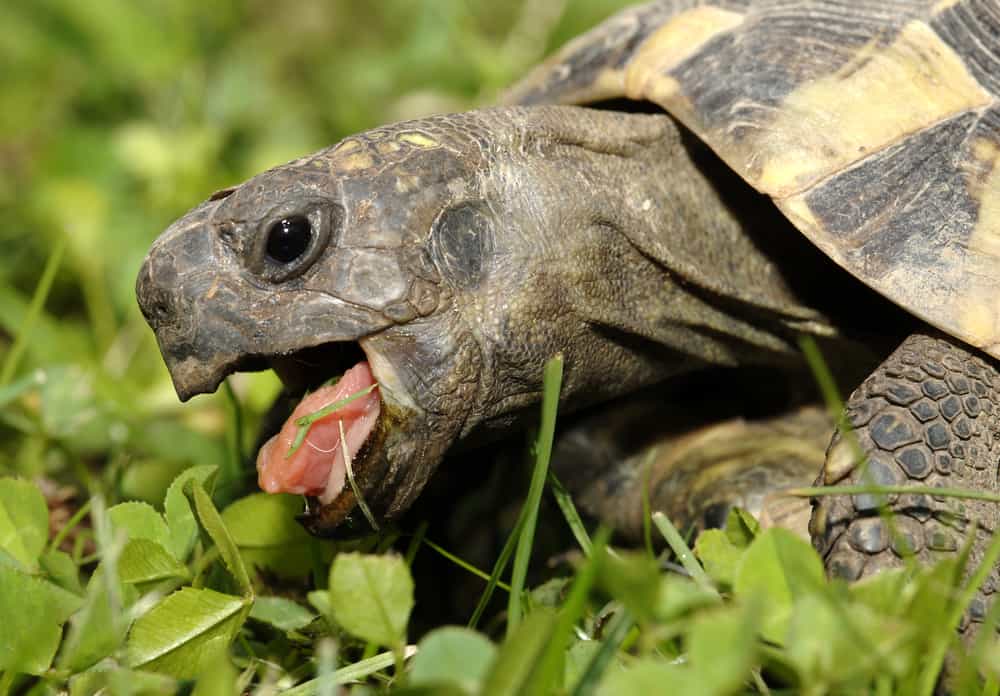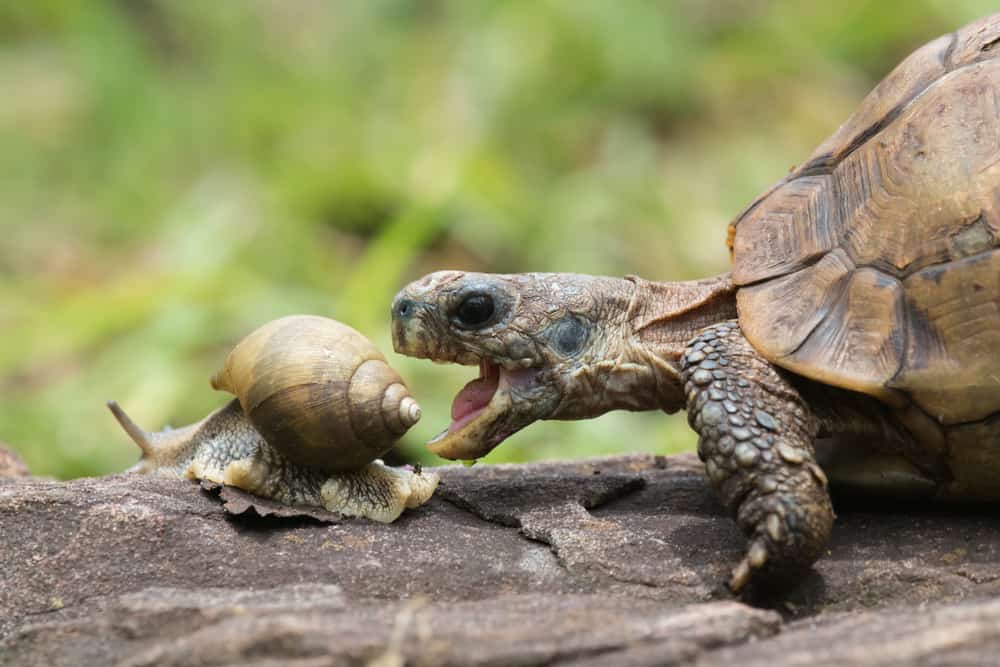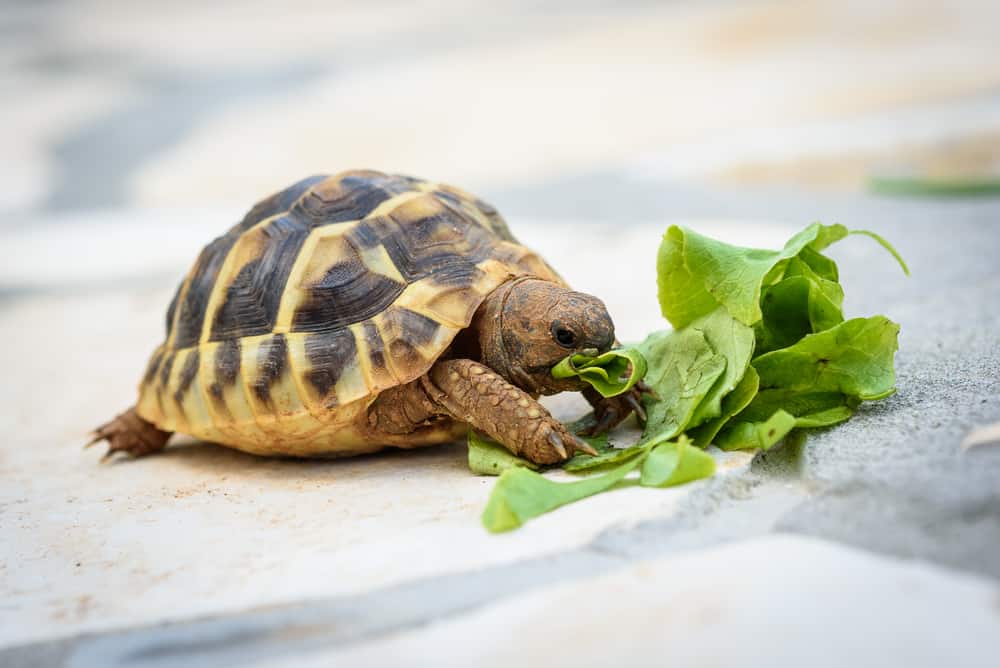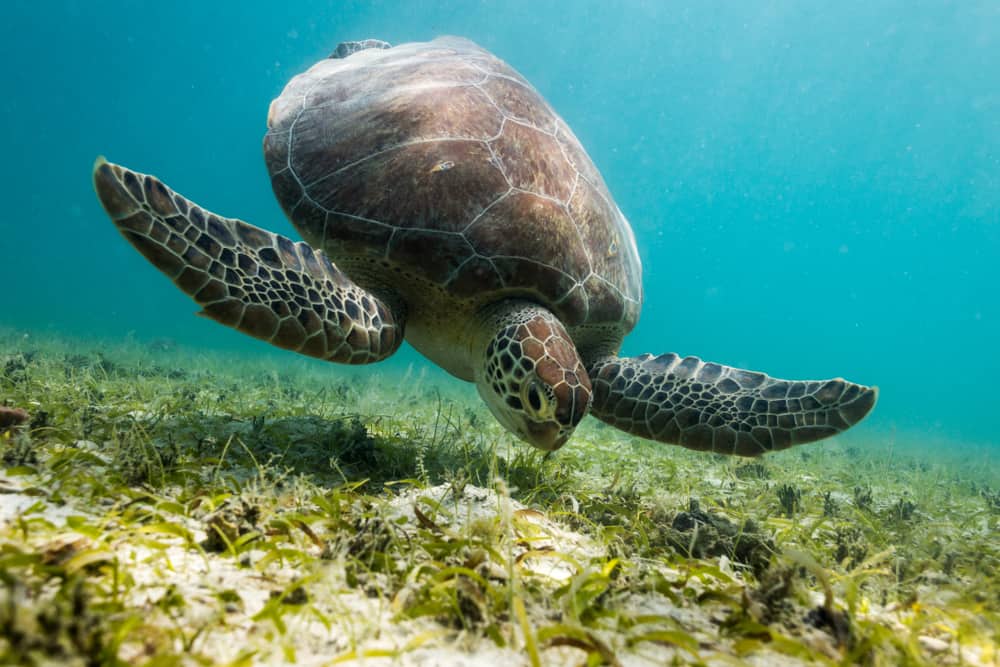You might struggle telling the difference between a turtle and a tortoise. (And we can help with that!) But even among turtles, you have over 300 species to identify. And what they eat depends on their variant. We’ll look at turtles in general and the best thing to feed them.
Turtle Habits and Biology
What do you know about tortoises and turtles? First off, turtles have been around longer. Which means a tortoise is a type of turtle. And turtles are popular enough that people volunteered and rescued them during that infamous Texas blackout. The turtles were cold-stunned. So they were captured, hidden up in a warehouse, then released in warmer waters.
When we (humans) are warm-blooded mammals. So when we feel cold, we can use clothes, heaters (or goosebumps) to warm ourselves up. Turtles – like tortoises – are cold-blooded reptiles. When they get too cold, they have to sit on a rock and bask in the sun to raise their body temperatures. And when they’re underwater, they can only survive in waters over 50°F.
Below that, they can’t move their bodies and may drown. So if you have turtles at home, warm their water in the winter. Turtles are slimmer and lighter than tortoises, with flattened shells and flipper-like legs. This is because they spend more of their lives in water, unlike their tortoise cousins that love land more. Turtle bodies are better adapted for swimming.
As a pet, turtles can live 20 to 40 years. But sea turtles can live hundreds of years. One of the recent Texas rescues was 150 years old. In the wild, turtles come on land to lay eggs about 150 eggs and bury them. The eggs hatch and find their way back to the ocean. Only about 15 hatchlings make it. So if you’re raising turtles, you’ll have to actively protect the eggs.
Turtle eggs can take 2 or 3 months to hatch. Most turtle species are omnivores, so we’ll focus on that feeding model. Double-check which breed you have though since some are ‘vegan’ while others are carnivorous. You should also confirm whether you’re raising freshwater turtles or saltwater (sea) turtles. Their habits, habitats, maintenance needs, and diets vary.
If you’re stuck between a tortoise and a turtle as a pet, turtles need less space (an aquarium will do) but are less ‘cuddly’. Tortoises are ‘social’ and can be touched more, but are bigger and live longer. But these are both reptiles so they don’t enjoy handling as much as mammals.
Do Turtles Eat Dirt?
In the US, turtles are mostly kept as pets. Some turtle farms breed them for research and export. In Asia, turtle farms supply these reptiles for food and medicine. So what your turtles eat may depend on where they live and why you keep them. Herbivorous or omnivorous turtles eat bugs and insects in addition to algae, grass, and plants. So they may pick soil.
But your turtles aren’t eating the soil itself. They’re sifting through it for appropriate food. Even their tortoise niblings hang out on land and seem to ‘chew’ dirt a lot. But they’re not eating soil either. Animals that eat dirt often have a pica deficiency so they’re drawing calcium from the soil. Reptiles can get calcium from fish and aquatic dishes so they’re good.
What Do Turtles Like to Eat Most?
If you got your turtle from the pet store, the staff can probably tell you what species your new pet is. So they can advise you on their preference (herbivore/carnivore/omnivore). In the wild, turtles only come up for air, sunshine, or to lay eggs so you don’t need to feed them.
- At home, turtles can eat high-calcium fruits like figs, strawberries, dates, raspberries, and apricots. Only 10 to 20% of their food is fruit, with leafy veggies up to 80%.
- Flowers are okay in moderation. Try carnations, dandelions, geraniums, hibiscus, roses, or nasturtiums.
- Some fruit should be limited because their high sugar and wrong nutrient ratio can be a problem for turtles. But they can eat small portions of pears, apples, and mangoes.
- You can also serve small chunks of melons, tomatoes, guavas, peaches, raisins, star fruit, kiwis, and unpeeled bananas. Not too much though.
- Given a choice, opt for veggies rather than fruit. Top selections include leafy greens from the kale and cabbage family (collard, watercress, broccoli, etc.).
- Legumes are okay in moderate amounts – try peas and green beans. Box turtles also enjoy small doses of mushrooms, cucumber, carrots, corn, and cactus.
- Beaked sea turtles enjoy crabs, sponges, algae, seagrass, shrimp, squids, sea cucumbers, and cuttlefish. They also enjoy boiled eggs.
- Freshwater turtles prefer worms, larvae, snails, and fruit that fell in the water.
- To feed turtles in the water, you can use floating ‘food sticks’ like ReptoMin. They contain meat and veggies and are enriched with calcium and Vitamin C.
- Turtles love insects like crickets, grasshoppers, beetles, caterpillars, and worms. Don’t ‘hunt’ them though – you may find insects that have fed on pesticides.
- For meaty content, try Fluker’s Buffet Blend. It has a mixture of freeze-dried worms, pellets, shrimp and is suitable for underwater feeding in a tank or pond.
- This aquatic buffet contains some soybean, poultry meal, fish meal, gluten, and corn. For carnivorous turtles, go for Fluker’s Medley instead (shrimp, crickets, worms).
- Turtles will eat dead animals in a pinch (carrion, aquatic road kill, etc.) but that’s not the healthiest. Keep a pack of turtle pellets in your pet pantry for quick feeding.
If you’re visiting turtles in a park or zoo, the staff will tell you whether you can feed them or not. In case it’s allowed, the zookeepers will give you the right food. Don’t try to sneak in contraband snacks. You may think it’s a treat, but you could hurt the reptiles’ health.
Foods to Avoid When Feeding Turtles
Box turtles are a common pet, and they almost look like tortoises. But even for other turtle types, there are some foods you should avoid if you can. They include:
- Light leaves like lettuce or celery – too much fiber, not enough nutrients.
- If plants have darker outer leaves with softer or lighter colors on the inside, dodge the lighter parts.
- Bread – for similar reasons. It’s a lot of processed starch and minimal nutritive value.
- Plants with oxalates and goitrogens can stop your turtle from metabolizing calcium so keep the spinach and swiss chard in the tiniest amounts possible.
- You can buy wilted flowers at close to free, but check what pesticides and herbicides were used by the florist shop. Some of those chemicals could be toxic to your pet.
- For live feeding, ‘grow’ your own insects or buy directly from pet stores. This avoids feeding your turtles food that’s laced with chemicals (herbicides, pesticides, etc.)
- You can buy commercial foods that have dried fish or dehydrated mealworms. Mostly freeze-dried. But don’t buy plain dried shrimp. They’re just potato chips for turtles.
- Don’t give your turtles dairy (cheese, yogurt, butter, etc.). They can’t digest it.
Don’t rush for the easiest or most convenient food. Offer your turtle a mix of decadent treats and nutritious options. It’s okay for a few dishes to be boring, but mix the textures, colors, and flavors available. The diet should be as close as what your turtle would get in the wild.
Tips to Feed Turtles
Turtles seem so sedate and move so slowly that it doesn’t seem complicated to feed them. But there are certain do’s and don’ts. These pointers will keep their flippers fabulous and full.
- Check the nutrient ratio. You want more calcium and less phosphorus.
- If it has far less calcium than phosphorous, offer it in small volumes e.g. bananas.
- That said, offer calcium and phosphorus supplements twice a week.
- These should be powdered form, sprinkled over their food.
- The calcium can be calcium carbonate, calcium lactate, or calcium gluconate.
- If you prefer organic calcium, bake eggshells for 30 minutes at 300°F.
- Grind this a blender and sprinkle over your turtle food.
- Toss some multivitamin powder in there as well – but only once a week.
- Be careful not to overdose on Vitamin D3.
- For land turtles, use wide, shallow bowls to feed you turtles.
- These bowls should be tough to tip, especially for box turtles.
- For apples and pears, core them first – the seeds can be toxic to turtles.
- Younger turtles need more meat while older ones need more vegetables.
- So the babies should get plants once a week while seniors get meat weekly instead.
- You can use one ‘feeder fish’ per day. That’s a live fish for your turtle to hunt.
- Keep an eye on the fish and remove its skeleton and entrails after it gets eaten.
- This is because the rotting leftovers could turn the water toxic for your turtle.
- You can also grow water plants separately then feed them to your turtles.
- Good choices include hyacinth, lettuce, hornwort, duckweed, anachris, or frogbit.
- Turtles can eat raw meat … but it may rot before they eat it so avoid it.
- Beaked turtles have scissor-like edges on their mouths, so they can tear off food.
- But if you’re offering whole food (as opposed to pellets) cut it into bite-sized chunks.
Like all pets, keep your turtle bowls clean and disinfected. You can wash them with dishwashing liquid. Water bowls should be washed and filled with clean water every day.
Turtle FAQs
Telling tortoises apart from turtles may have been your biggest question. But there’s much more to consider whether you’re keeping turtles for science or companionship. Here are a few common questions about turtles. And some of them apply to tortoises as well.
1. Can turtles hide in their shells?
All tortoises can retract, and some turtles can as well. But some turtle species are unable to tuck their head and feet into their ‘houses’ so ask the pet store owner if you’re unsure.
2. What do pet turtles live in?
Ask the pet store if your turtle is a lake/river reptile (freshwater) or an ocean/sea reptile (saltwater). Then get an aquarium with the right filters and accessories plus a basking spot.
3. How big do pet turtles get?
Turtle shells are made of keratin. That’s the same stuff your nails are made of. In the ocean, turtles can live hundreds of years and grow hundreds of pounds. Pet turtles reach their full size by 2 years and are roughly 5 to 11 inches so get a turtle tank that’s at least 40 gallons.
4. How do turtles eat?
Turtles are slow and have no teeth so how do they hunt? The herbivores eat plants and the omnivores eat mollusks that are equally slow. Some turtles have beaks with sharp jaws that snap to crack shells open. Other turtles have softer lips so they swallow their food whole.
5. Do turtles hunt?
Underwater, turtles don’t have many predators because their shells are too tough. And they’re rarely on land so it’s only hatchlings that are exposed. So turtles don’t need ‘speed’ to hunt. They just sidle up to slow animals. They can lure fish with their tongues and trap them.
6. Do turtles eat goldfish?
Yes, if you keep turtles in the same tank as fish, they’ll probably eat your fish. Also, turtles aren’t social and will sometimes fight other turtles in their tank. So while it’s possible to have fish and turtles in the same tank, it takes a lot of care and attention to avoid piscicide.
7. Can turtles eat birds?
If it catches the bird, yes. Snapping turtles grow large and have powerful jaws. They’ve been photographed eating pigeons and even ducks, so don’t let that ambling gait fool you! They opt for slower birds though. So ducklings or dead birds. Turtles sometimes hunt mice as well.
8. How do straws hurt turtles?
Straws have sharp edges so they can pierce a turtle’s organs when they swallow it. Turtles can choke on the plastic. It can block their breathing passages or clog their digestive system.
9. Do turtles fight jellyfish?
Jellyfish are among the scariest creatures in the ocean. And yes, some turtles snack on them. Leatherback turtles feed almost exclusively on jellyfish and they can grow to be 1,500lbs.
10. Can turtles eat grapes?
If you offer fruit to your turtle s/he’ll probably eat it. But the sugar in grapes and their ratio of calcium-phosphorus isn’t the best for reptiles. Keep fruits and flowers in low rotation.
You probably have lots more questions about turtles, but this is a good starting point. Ask the pet store owner if they know what species of turtle you have and if they have specific tips.
Summary
If you want an aquatic indoor pet, a smaller turtle is a good choice. You can keep them outdoors in a stock tank or a pond. Either way, provide safe basking spots, the right food for your turtle breed, a filter if you have an aquarium, and adequate swimming space.



